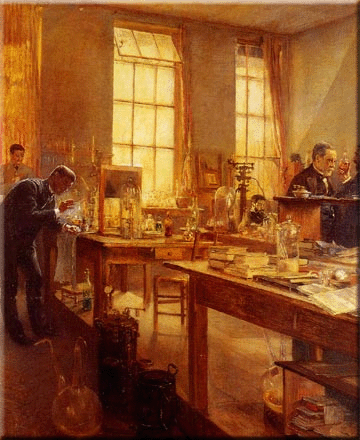
Louis Pasteur's laboratory where the smallpox vaccine was discovered
The magnifying glass is a mobile observational tool as discussed in The Magnifying Glass, Optical Constancy and Mobility, allowing observation of specimens in nature without placing any demands on an object's setting. The microscope, on the other hand, is a fixed tool requiring a particular setting for examination (a room inside, a power source, a table or other surface, etc.), eliminating the mobility and flexibility of the magnifying glass. Additionally, techniques required to visualize a specimen under the magnifying glass such as stains, slides, and slicing tools impede mobility and require the transfer of a specimen to a specialized setting in order to be examined.
The shift to microscopy furthered the human tendency to externalize vision, enabling more efficient evolution in visualization methods. By employing techniques beyond that of a simple lens, the microscope extends the capabilities of the eye to a much greater extent than the magnifying glass, using multiple lenses, light sources, and other advanced technologies.
The microscope demanded a particular setting for scientific investigation known as the laboratory. The transfer of a specimen to a laboratory in order to undergo observation increases a specimen's distance from nature without fundamentally altering it. Increasing the distance of humans from nature is attributed to a preservation of objectivity, as examined in Vision and the Magnifying Glass. The laboratory itself is also associated with increased scientific authority as explained by Bruno Latour in his work "Give Me A Laboratory and I Will Raise The World," in which Louis Pasteur's laboratory and the discovery of the smallpox vaccine illustrates the laboratory's power through creating a setting isolated from nature and society in which to pioneer methodology, ultimately producing visual proof within nature.
The context for observation shifts from nature to the laboratory with the invention of the microscope, the ultimate increase in distance from nature. “People before science and outside laboratories certainly use their eyes, but ...they look at the spectacle of the world,...not at this new type of image designed to transport the objects of the world, to accumulate them..., to label them with captions and legends, to combine them at will" (Latour, Visualization 9). In turn, the objectivity of the laboratory enabled by the microscope rendered it the preferable technology of magnification in science.
Back to The Microscope versus the Magnifying Glass.
(Image Source: http://www.sb-roscoff.fr/CyCell/ArtGallery/PasteurLabo.jpg)
